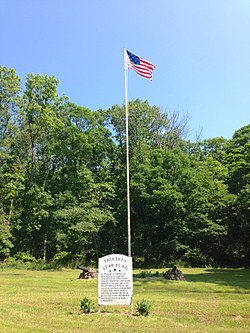"Middlebrook encampment" may refer to one of two different seasonal stays of the Continental Army in central New Jersey near the Middlebrook in Bridgewater Township in Somerset County. They are usually differentiated by either the date of the encampment or their chronological order (First vs Second).
Middlebrook Encampment Site | |
 A Thirteen Star Flag at the Middlebrook encampment is displayed continuously. | |
| Location | Middlebrook Road, Bridgewater Township, New Jersey |
|---|---|
| Coordinates | 40°34′45″N 74°32′16″W / 40.57917°N 74.53778°W |
| NRHP reference No. | 75001160[1] |
| NJRHP No. | 2485[2] |
| Significant dates | |
| Added to NRHP | July 3, 1975 |
| Designated NJRHP | May 8, 1975 |
The First Middlebrook encampment refers to the spring encampment of the Continental Army, commanded by General George Washington, during the American War for Independence near the Middle Brook in Bridgewater Township, New Jersey (between Martinsville and Bound Brook) in 1777. The second, longer winter cantonment took place in 1778–1779, from December 1 to mid-June. A cantonment is a protracted quartering of an army in a specific location, typically for the duration of the winter.[3]
A portion of the first encampment site, known as the Washington Camp Ground, was added to the National Register of Historic Places on July 3, 1975. The Campground is located in Martinsville, a section of Bridgewater Township. The Middlebrook Encampment site includes part of the ridge of the First Watchung Mountain. Its position provided a natural fortress not only protecting the Continental Army but also overlooking the plains towards New Brunswick, where the British forces were stationed in 1777. A surviving earthen redoubt believed to date to the 1777 encampment is also located on the mountain within Washington Valley Park.[4] The strategic strength of the army's position on the Watchung or Blue Mountain ridge contributed ultimately to the success of the Continental Army by lengthening the war and wearying the British forces during both of the army's stays.[5][6][7][8]
- ^ "National Register Information System". National Register of Historic Places. National Park Service. July 9, 2010.
- ^ "New Jersey and National Registers of Historic Places - Somerset County" (PDF). New Jersey Department of Environmental Protection - Historic Preservation Office. August 22, 2016. p. 4. Archived from the original (PDF) on May 16, 2013.
- ^ Barth, L., Blinn, S. & Sullivan, M.W. (Eds.) (2021). The Continental Army Comes Into Its Own: The Middlebrook Cantonment of 1778-1779. USA: The Heritage Trail Association. pp. 105–108. ISBN 9798454162528.
{{cite book}}: CS1 maint: multiple names: authors list (link) - ^ Veit, R., Brown, M., & Fouad, G. (2021). "Archaeology of the Middlebrook Encampments: Problems and Prospects", in The Continental Army Comes Into Its Own: The Middlebrook Cantonment of 1778-1779. USA: The Heritage Trail Association. pp. 105–123. ISBN 9798454162528.
{{cite book}}: CS1 maint: multiple names: authors list (link) - ^ Lossing, Benson John (1921). The Pictorial Field Book of the Revolution, Vol. 1. New York: Harper and Brothers, Publishers. pp. 331.
- ^ Veit, Richard Francis (2002). Digging New Jersey's Past: Historical Archaeology in the Garden State. Piscataway: Rutgers University Press. p. 65. ISBN 9780813531137.
- ^ "Crossroads Feasibility Study". National Park Service. August 2002. p. 29. Retrieved 9 August 2014.
- ^ Di Ionno, Mark (2021). "How the Watchung Mountains Won the Revolution" in The Continental Army Comes Into Its Own: The Middlebrook Cantonment of 1778-1779. USA: The Heritage Trail Association. pp. 15–18. ISBN 9798454162528.


